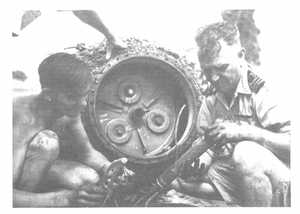- Author
- Turner, Mike
- Subjects
- Biographies and personal histories, RAN operations, WWII operations, History - WW2
- Tags
-
- RAN Ships
- None noted.
- Publication
- June 2010 edition of the Naval Historical Review (all rights reserved)
Lieutenant Commander Goldsworthy, GC, DSC, GM, RANVR and Lieutenant Commander Cliff, GM*, MBE, OBE, RANVR transferred from Europe late in 1944 (or early in 1945) to serve with MEIU No. 1. At this stage, the two Australian officers with MEIU No. 1 were rotated about every six months, and they probably replaced Lieutenants Billman and Hunter circa May 1945. Their operations followed the American invasion of the Philippines and Australian invasion of Borneo.

In June 1945 two new ‘P’ Parties were formed for service in the Far East, one under Lieutenant George Gosse, GC, RANVR and the other under Lieutenant Maurice Batterham, RANVR (Sp.). V-J Day came earlier than expected, and these two parties were disbanded.
The main RAN post-war effort was in the Rabaul-Kavieng area where large stocks of mines were destroyed. At Rabaul Acting Lieutenant Commander C.G. Croft, MBE, RANR was RMS and Bomb Disposal (BD) Officer, and Acting Lieutenant Commander M.S. Batterham, RANVR (Sp.) was his assistant.
Numerous bombs and mines were located at Rabaul deployed as beach defences and booby traps. These obstacles were fitted with fuses, igniters and specially weakened mine horns, and were connected to concealed trip wires which had to be located. The bombs and mines were found in shallow water and on cliff faces. The work was carried out by Lieutenant Commanders Croft and Batterham with three ratings, Sotheren, Hills and Hubbard.
At the end of 1945 Lieutenant Commander Croft located German made magnetic and acoustic mines at Rabaul. These were almost certainly German GS (TMB) submarine laid mines, the type of mine laid by Japanese submarine I-6 at Brisbane on 13 March 1943.

An Army officer, when officially commending the RAN RMS party at Rabaul, noted that ‘the work was dangerous and difficult and involved working in many cases under water and in confined tunnels.’
NOIC New Guinea reported to Navy Office that the RMS party at Rabaul was a small select band of experts of whom he had formed a very high opinion.
There were plenty of bomb disposal tasks for RAN personnel in three successive Army/Navy units in the British Solomon Islands from July 1950 to April 1953. The first unit was led by Lieutenant Commander Croft, and included three Able Seamen – Vic Turner, Ned Sparkes and John ‘Tubby’ Edgar.
The rendering safe of World War II mines is an ongoing task for RAN Clearance Divers. An enquiry by the author on 11 March 2004 found that the most recently located World War II mine was a British Mk XVII moored mine found on rocks at Port Stephens, NSW. It had been rendered safe by RAN Clearance Diving Team 1 only two days earlier!
Australian Government policy on awards for post-war RMS operations
Mines were blissfully unaware of the cessation of other hostilities. Post-war mine clearance, be it minesweeping or RMS operations, was identical to war-time mine clearance. The British Government recognized post-war mine clearance as operational, and presented honours and awards for such operations. However Australian Government policy precluded awards for post-war RAN mine clearance.
In December 1948 CNS, Rear Admiral John Collins, CB, RAN, wrote to the Minister for the Navy, W.J.F. Riordan, recommending a MBE for Lieutenant Commander Batterham, a MID for Lieutenant Commander Croft, and a BEM for Leading Seaman Victor Sotheren, RAN for clearing mines, bombs and booby traps in the Rabaul area under difficult and dangerous conditions. He also made recommendations for honours and awards for eleven officers and sailors in the 20th Minesweeping Flotilla engaged in post-war minesweeping operations. In his submission CNS pointed out that by the end of 1948 the British government had made 86 awards for minesweeping and mine and bomb disposal – decorations for 13 officers and 25 ratings, and MIDs for 9 officers and 39 ratings. CNS stated that:
It is my firm opinion that the post-war operations of the 20th MSF and RMS parties were in all respects ‘operational’ within the meaning of Cabinet decision – the loss of HMAS Warrnambool exemplifies this. If however there should be any doubt about the matter, in that offensive operations ceased on 15th August, 1945, then the names of the personnel are submitted for non-operational awards, as clearly each exhibited courage and brave conduct.




